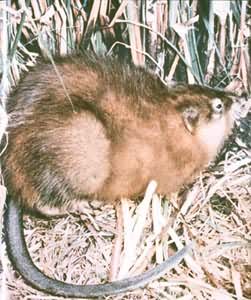
 |
 |
Muskrat
Ondatra zibethicus

Muskrat. Photo:Mont St-Hilaire Nature Center
Found throughout Canada, the muskrat is well adapted to an aquatic existence. It is often seen in a wide variety of aquatic environments such as lakes, rivers, ponds, and marshes. Muskrats are large (approximately sixty centimetres in length) and thus are one of the most important of all the fur-bearing animals. They are social animals, living in communes with other muskrats. They are generally nocturnal but will come out to feed during the daytime under cloudy conditions. In the winter, muskrats form a structure dubbed a 'push-up,' a dome-like structure which is made from frozen vegetation. These push-ups provide the muskrat with shelter on the ice through which it will enter the water. If stressed the muskrat is capable of remaining submerged for a maximum of 17 minutes, but will normally only remain underwater for 2-3. In the summer the muskrat will feed upon emergent vegetation such as cattails and sedges, but in the winter the diet is limited to submerged vegetation such as pond weeds.

![]() Distribution
of Muskrat in Canada
Distribution
of Muskrat in Canada
